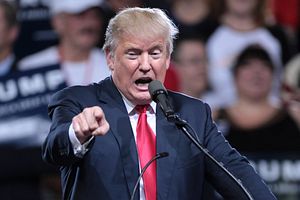Picture for a moment a situation where two nuclear-armed nations that have been sworn enemies for over 65 years are staring each other down, and both are threatening mutual annihilation. An inexperienced and loose-lipped Commander-in-Chief issues a public red-line that any military provocation would be met with “fire and fury.” A young, ruthless totalitarian responds with his own declaration that four intermediate-range ballistic missiles may be launched towards that state’s territory as soon as next week.
This series of events reads like a Hollywood thriller, but unfortunately this isn’t a play or a movie; it’s a real life situation between U.S. President Donald Trump and North Korean Supreme Leader Kim Jong-un — one that could easily spiral out of control.
One doesn’t need to be a theorist in an Ivy League war studies department to recognize where this war of words between Trump and Kim can go. For decades, think tanks, research institutes, defense ministries, and defense contractors have war-gamed what would likely occur if the U.S. launched a preemptive attack against the North Korean leadership or air strikes on Kim’s missile silos and nuclear sites. Most expect an immediate North Korean artillery barrage of the South Korean capital, an attack that would kill at least tens of thousands of people (including thousands of Americans who live in Seoul); stronger retaliatory action against Pyongyang by U.S. and South Korean forces with a larger list of targets; and perhaps North Korean missile strikes on Tokyo. The world would witness so much carnage in such a short period of time that it would make the 1950-1953 Korean War look like a minor Cold War scuffle.
Neither Trump or Kim wants to go down this road, yet the language that both have chosen to use has had the adverse effect of dragging their nations into the possibility of an armed dispute. Neither wants to blink or back down for fear of being perceived around the world as weak.
It’s time for that vitriol to stop.
It’s not clear that Pyongyang is in any mood to make the first move towards deescalation, so it’s incumbent on the United States to keep its ego in check. After all, the North Koreans may at least be open to any diplomatic efforts that Washington has to offer.
First, President Trump should authorize the State Department to make diplomatic contact with Pyongyang. This can be done through secret channels, either through North Korea’s UN Mission in New York or through direct dialogue between senior State Department officials and counterparts in the North Korean Foreign Ministry. The U.N. channel has been a reliable path of communication for U.S. administrations in the past; indeed, the Trump administration utilized North Korea’s U.N. Mission this year to begin the process of bringing detained American student Otto Warmbier home. Since the U.S. and North Korea don’t have formal diplomatic relations, this is likely the quickest, most reliable, and most politically tenable way for the White House to approach Kim’s people.
Once contact is initiated, the U.S. can deliver a clear and unequivocal message to the Kim regime — a message far more cogent than the mixed messaging of the last week. The central purpose of the missive would be to defuse the situation and increase Pyongyang’s understanding of what Washington’s bottom-line is. The Trump administration should use the opportunity to demonstrate to the North Koreans that the U.S. does not want military conflict with the North; has no desire of overthrowing Kim Jong-un or forcing a reunification of the Korean Peninsula under Seoul’s direction; believes that it would be in the best interests of everyone to lower the temperature; all the while making it clear that the U.S. will retaliate if its citizens or allies are under imminent threat of a North Korean attack. The objective is relatively simple, albeit essential: ensure that the Kim regime and the Trump administration are able to discern each other’s red lines and minimize the risk of misreading one another’s motives.
Assuming that deescalation does occur and both countries step back from war-like threats, U.S. and North Korean officials can then begin the long and slow road of launching new long-term negotiations. Because denuclearization is no longer practical — Pyongyang would likely resist any talks where denuclearization is the ultimate objective — Washington should offer something a negotiating agenda that is more tangible. While demanding that North Korea dismantle its nuclear and missile programs is unrealistic, the North Koreans may accept negotiations on traditional arms control matters. The U.S. loses nothing and could gain quite a lot by exploring whether Kim Jong-un is willing to cap the amount of nuclear weapons he possesses in his arsenal, place a moratorium over any additional ICBM research, development, and testing, and re-admit International Atomic Energy Agency inspectors into his country. In exchange, Washington could suspend work on any additional sanctions resolutions in the U.N. Security Council, but he prepared to resume work if Pyongyang stonewalls on their commitments.
None of this may be palpable enough to produce a formal accord. Indeed, these suggestions will be very unpopular on Capitol Hill, where many lawmakers are still aiming for the full and complete abolition of North Korea’s nuclear weapons program. But what was possible in the 1990’s is no longer possible in 2017. The U.S. can either bark up an impossibly tall tree, or it can face reality, defuse the prospects of a war that nobody wants, and engage in pragmatic diplomacy that at least has a chance of succeeding. On North Korea, even partial wins can be celebrated.
Daniel DePetris is a fellow at Defense Priorities.

































